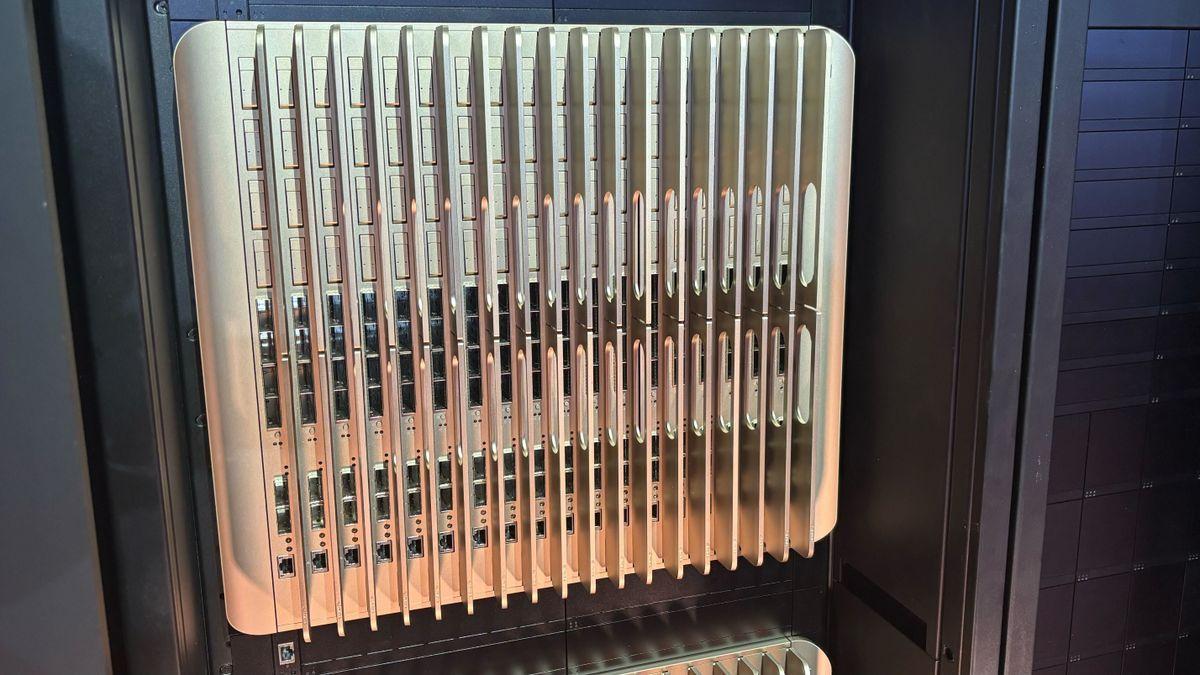Semiconductor Industry Faces Challenges Amid Global Economic Uncertainties
2 Sources
2 Sources
[1]
Global server shipments up both 2Q24 and 3Q24 thanks to major CSPs in US, says DIGITIMES Research
Global server shipments grew by 7.3% sequentially in the second quarter of 2024, surpassing previous forecasts. The main reasons are the initiation of general-purpose server updates by more large US cloud service providers and the continuous increase in procurement and shipments of high-end AI servers by cloud service providers and brand vendors, according to DIGITIMES Research's latest server report covering the second quarter and second half of 2024. The report's figures also show that global server shipments will likely grow by 1.6% sequentially in the third quarter, with the main contribution still coming from large cloud service providers. The four major North American cloud service providers will all see shipment growth, and the demand recovery seen in Chinese cloud service providers in the second quarter will likely continue into the third quarter. However, brand vendors may see shipment declines compared to the previous quarter. Due to the high base established in the previous two quarters and increased economic uncertainty, a slight decline compared to the prior quarter is expected in the fourth quarter of 2024. Full-year server shipments in 2024 will likely reach around 14.73 million units, a 2% increase from 2023. There was a significant recovery in overall server shipments in the second quarter of 2024. Large US cloud service providers, including Meta and Microsoft, initiated general-purpose server replacements, and AI server procurement by companies like Meta and Amazon remained in an expansion phase, leading to a 10.4% increase in procurement by these cloud service providers. After being struck by lockdowns during the COVID-19 pandemic and remaining dormant for several years, Chinese cloud services providers experienced a rebound, with shipments increasing by 11% quarter-on-quarter. Meanwhile, the shipment performance of brand vendors matched previous expectations, with a 4.8% quarter-on-quarter increase, mainly due to faster updates of general-purpose servers by enterprise customers and improved AI server supply conditions. In the third quarter of 2024, Google will likely launch another round of updates for its general-purpose servers. Additionally, Amazon's procurement of its Graviton processors and AI ASICs is expected to improve compared to the previous quarter, potentially driving a 6.1% quarter-on-quarter increase in procurement by large American cloud service providers. However, due to an already high shipment base and ongoing economic uncertainty among enterprise customers, brand vendors are likely to see a decline in overall shipments. Nevertheless, the strong performance expected from large cloud service providers in the third quarter will favor Taiwan-based server makers like Wiwynn and Quanta Computer, which focus on large cloud customers.
[2]
Global server market, 2Q 2024
Global server shipments up over 7% sequentially in the second quarter of 2024 with growth in the third quarter continuing to be driven by CSPs. Global server shipments grew by 7.3% sequentially in the second quarter of 2024, surpassing previous forecasts. The main reasons are the initiation of general-purpose server updates by more large US cloud service providers and the continuous increase in procurement and shipments of high-end AI servers by cloud service providers and brand vendors, according to DIGITIMES Research. DIGITIMES Research also notes that global server shipments will likely grow by 1.6% sequentially in the third quarter, with the main contribution still coming from large cloud service providers. The four major North American cloud service providers will all see shipment growth, and the demand recovery seen in Chinese cloud service providers in the second quarter will likely continue into the third quarter. However, brand vendors may see shipment declines compared to the previous quarter. Introduction Key factors affecting the global server market Chart 1: Global server shipments, 2Q23-4Q24 (k units) Shipments breakdown Chart 2: Global shipments by top-10 player, 2Q23-4Q24 (k units) Chart 3: Global shipment share by top-10 player, 2Q23-4Q24 Shipments from Taiwan makers Chart 4: Taiwan server shipments and global share, 2Q23-4Q24 (k units) Chart 5: Taiwan shipments by top maker, 2Q23-4Q24 (k units) Chart 6: Taiwan shipment share by top maker, 2Q23-4Q24 Foxconn Chart 7: Foxconn server shipments, 2Q23-4Q24 (k units) Chart 8: Foxconn shipments by client, 2Q23-4Q24 (k units) Chart 9: Foxconn shipment share by client, 2Q23-4Q24 Inventec Chart 10: Inventec server shipments, 2Q23-4Q24 (k units) Chart 11: Inventec shipments by client, 2Q23-4Q24 (k units) Chart 12: Inventec shipment share by client, 2Q23-4Q24 Quanta Chart 13: Quanta server shipments, 2Q23-4Q24 (k units) Chart 14: Quanta shipments by client, 2Q23-4Q24 (k units) Chart 15: Quanta shipment share by client, 2Q23-4Q24 Wistron Chart 16: Wistron server shipments, 2Q23-4Q24 (k units) Chart 17: Wistron shipments by client, 2Q23-4Q24 (k units) Chart 18: Wistron shipment share by client, 2Q23-4Q24 Mitac Chart 19: Mitac server shipments, 2Q23-4Q24 (k units) Chart 20: Mitac shipments by client, 2Q23-4Q24 (k units) Chart 21: Mitac shipment share by client, 2Q23-4Q24 Wiwynn Chart 22: Wiwynn server shipments, 2Q23-4Q24 (k units) Chart 23: Wiwynn shipments by client, 2Q23-4Q24 (k units) Chart 24: Wiwynn shipment share by client, 2Q23-4Q24 Client-maker server shipment matrix Chart 25: Client-maker partnership matrix, 4Q24 (k units) Chart 26: Client shipment share by maker, 4Q24 Chart 27: Maker shipment share by client, 4Q24 Chart 28: Client-maker partnership matrix, 3Q24 (k units) Chart 29: Client shipment share by maker, 3Q24 Chart 30: Maker shipment share by client, 3Q24 Chart 31: Client-maker partnership matrix, 2Q24 (k units) Chart 32: Client shipment share by maker, 2Q24 Chart 33: Maker shipment share by client, 2Q24 Chart 34: Client-maker partnership matrix, 1Q24 (k units) Chart 35: Client shipment share by maker, 1Q24 Chart 36: Maker shipment share by client, 1Q24 Annual shipments Chart 37: Taiwan and global server shipments, 2020-2024 (k units) Chart 38: Global server shipments by top-10 player, 2023-2024 (k units) Chart 39: Taiwan server shipments by top maker, 2023-2024 (k units) Summary
Share
Share
Copy Link
The semiconductor industry is experiencing a slowdown due to global economic uncertainties and geopolitical tensions. Despite this, there are signs of recovery and opportunities in emerging technologies.

Global Economic Uncertainties Impact Semiconductor Industry
The semiconductor industry is currently navigating through a period of significant challenges, primarily driven by global economic uncertainties and geopolitical tensions. According to recent reports, the industry is experiencing a slowdown that has affected various segments of the market
1
.Market Dynamics and Regional Impacts
The impact of these challenges is not uniform across all regions. While some areas are experiencing more severe downturns, others are showing signs of resilience. For instance, the Greater China region, which includes China and Taiwan, has been particularly affected by the current market conditions
1
.Inventory Adjustments and Production Cuts
In response to the market slowdown, many semiconductor companies have been forced to make significant adjustments to their operations. This includes inventory reductions and production cuts to align with the decreased demand. These measures are seen as necessary steps to maintain financial stability during this period of uncertainty
1
.Signs of Recovery and Future Outlook
Despite the current challenges, there are indications that the semiconductor industry may be on the path to recovery. Industry analysts and company executives have noted some positive trends that suggest a potential turnaround in the near future
2
.Emerging Technologies and New Opportunities
Amidst the challenges, the semiconductor industry is also seeing new opportunities emerge, particularly in the realm of advanced technologies. Areas such as artificial intelligence (AI), high-performance computing, and next-generation communication technologies are driving demand for more sophisticated semiconductor products
2
.Related Stories
Industry Adaptation and Innovation
To navigate these challenging times, semiconductor companies are focusing on innovation and adapting their strategies. This includes investing in research and development for new technologies and exploring new market segments that show promise for future growth
2
.Global Supply Chain Reconfiguration
The ongoing geopolitical tensions and trade disputes have prompted a reconfiguration of global semiconductor supply chains. Companies are increasingly looking to diversify their manufacturing and sourcing strategies to mitigate risks associated with over-reliance on specific regions
1
.Long-term Industry Prospects
Despite the current headwinds, the long-term prospects for the semiconductor industry remain positive. The increasing digitalization of various sectors and the growing importance of semiconductors in emerging technologies suggest that demand will continue to grow in the coming years, albeit with potential short-term fluctuations
2
.References
Summarized by
Navi
[1]
[2]
Related Stories
Global Server Market Soars 91% in 2024, Driven by AI and GPU Demand
19 Mar 2025•Technology

Nvidia Secures Entire Wistron Server Plant Capacity Through 2026 for AI Hardware Production
21 Jun 2025•Business and Economy

Dell's AI Server Demand Drives Strong Profit Outlook and Record Backlog
30 May 2025•Business and Economy

Recent Highlights
1
Google launches Gemini 3 Flash as default AI model, delivering speed with Pro-grade reasoning
Technology

2
OpenAI launches GPT Image 1.5 as AI image generator war with Google intensifies
Technology

3
OpenAI launches ChatGPT app store, opening doors for third-party developers to build AI-powered apps
Technology





